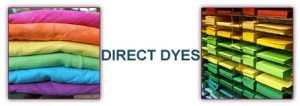
Direct dyes are one of the most commonly used dyes in the textile industry. Used largely on cotton fabrics these dyes offer ease of application besides being economical. The fastness and the dyeing properties of the varied colorants that are included under direct dyes are two important aspects that are of relevance to the dyer as he tackles problems encountered in dyeing.
These dyes are classified into three groups based on their compatibility with one other as they undergo batch dyeing under controlled conditions. Class A comprises of self-leveling dyes that offer uniform dyeing in spite of addition of the electrolyte at the start of the operation. Class B comprises of salt-controllable dyes which have comparatively lesser leveling properties. Addition of the electrolyte in controlled quantities as the dye bath reaches the desired dyeing temperature helps in uniform batch dyeing. Class C comprises of temperature and salt controllable dyes which exhibit comparatively poor properties of leveling. Control has to be exercised over the addition of salt and rate of temperature increase for better dyeing purposes.
The dye bath related variables playing a significant role in affecting the dyeing behavior are the dyeing times, temperature, dye solubility, liquor ratio and existence of electrolyte. The methods adopted for dyeing varies from batch dyeing to semi-continuous methods like pad roll or pad-batch or continuous methods like pad steam. A combination of scouring and dyeing is suitable for certain direct dyes. This method entails the use of a non-ionic detergent and soda ash. The fastness characteristics and the coloring effect on varied fibers differ from dye to dye. Direct dyes work best on cellulose fibers though they are effective for staining wool and silk with the addition of ‘reserving agent’. However, the wash fastness of most of these dyes is not so good though they are better with regard to the property of light fastness. Due to this there is a dye-bleed during every wash. This leads to staining other clothes present in the wash load and reducing the vibrancy of the clothes.
The poor wash fastness quality of these dyes can be improved through a special treatment known as the ‘special after treatment’. It involves the use of a cationic bulking agent called ‘Retayne’. This substance enhances the gluing of the dye onto the fiber and ensures the elimination of dye-bleed. Other methods used for improving wash fastness include treating the dye with formaldehyde, treating with salts of copper like copper sulphate, treating a combination of copper sulphate and cationic agents, treating with resins or cross linking agents and lastly, Diazotization and development.
Basic dyes are largely used for dyeing acrylic fibers though they can be used for linen, cotton, polyesters along with a mordant. However, they have their own set of problems while dyeing and these are tackled differently. Pigments as colorants are also not free from certain issues and so pigment manufacturers including pigment blue manufacturers adopt certain measures to circumvent the problems and ensure that they perform the function they are meant for and that is imparting bright colors to the varied items in our life!